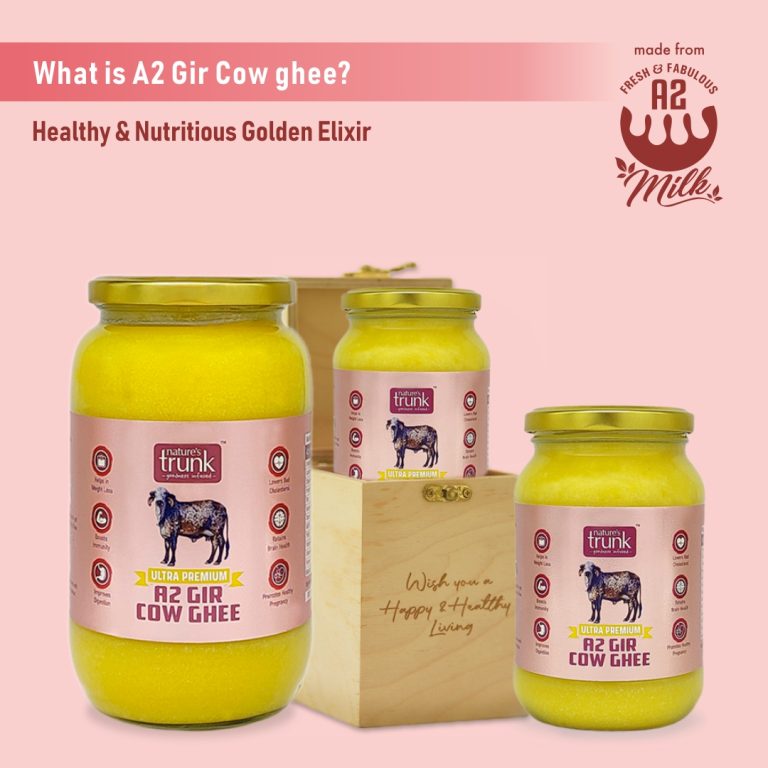What is A2 Gir Cow ghee? Why it is superior to other Ghee?

What is A2 Gir Cow ghee?
A2 Gir Cow Ghee is a type of ghee that is derived from the fresh & pure milk of Gir Cows, an indigenous Indian breed known for its unique characteristics. Gir Cows are easily identifiable by their fascinating physical appearance round & domed forehead, distinctive large hump, long ears, twisted horns, prominent dewlap, long hairy tale, big udder and gentle temperament.
These cows have been revered for centuries and are considered one of the oldest and most important indigenous cow breeds in India.
What sets A2 Gir Cow ghee apart from other types of ghee is the type of milk used in its production. Gir Cows naturally produce A2 beta-casein protein in their milk, which is different from the A1 beta-casein protein found in the milk of hybrid foreign cow breeds. This distinction is based on the genetic variation of the cows’ beta-casein genes.

The presence of A2 beta-casein protein in the milk of Gir cows is believed to be associated with several benefits. A2 beta-casein may be easier to digest and less likely to cause digestive discomfort compared to A1 beta-casein.
It is thought that the digestion of A1 beta-casein can release a peptide called beta-casomorphin-7 (BCM-7), which may have adverse effects on some individuals.
However, A2 beta-casein does not produce BCM-7, leading to the belief that A2 milk and ghee made from it are more suitable for consumption.
To produce A2 Gir cow ghee, the milk obtained from Gir cows is typically processed using traditional methods passed down through generations. One such method is the Bilona process, which involves churning the curd made from A2 milk using a wooden churner.
This process separates the butterfat from the buttermilk, and the butterfat is then heated on a gentle firewood flame until it transforms into ghee.
The Bilona process is considered to be a time-honoured and labour-intensive method of ghee production. This process helps retain the ghee’s purity, nutritional content, and natural flavours.
The slow heating on a firewood flame imparts a unique aroma and taste to the ghee, distinguishing it from ghee produced using modern methods.
A2 Gir cow ghee is highly regarded for its rich flavour, golden colour, and aromatic qualities. It is valued not only for its culinary uses but also for its potential health benefits.
It is rich in healthy fats, essential fatty acids, vitamins (such as vitamins A, D, E, and K), and minerals. Ghee is often used in traditional Ayurvedic practices and is believed to have various therapeutic properties.
Related articles
How Healthy Flour Helps in Weight Management and Increases Your Energy for a Balanced Life
Flour is a daily need in many families, but it is often picked without many thoughts. This is where many are lacking in picking the right one. The refined flour may look like a good option to go ahead, but all the natural fiber, nutrients, and minerals will vanish. This will further result in bad digestion, lack of energy, and weight issues. This can be addressed by replacing it with healthy, natural, whole-grain flour that helps in balancing the overall well-being. For many individuals, health is becoming a priority, and to maintain discipline with food, they are choosing healthy options and prefer to buy healthy flours online. Traditional methods and clean ingredients are the key for people to believe it is healthy flour. This will clearly explain that food is the fuel for long-term health. What is Natural and Traditional Flour and How Does It Benefit? "Natural" is the term that reflects that it is prepared without heavy processing or chemical methods and by using all whole grains, pulses, and seeds. This natural food powder contains all fiber, plant protein, nutrition, and essential micronutrients. Traditional mixes, such as Java mix, have additional nutrients for balancing health, not only to fill the stomach but also to nourish the body. As many are going with the trend to buy healthy flours online, the demand and its appreciation are increasing gradually in the daily lifestyle. Why Healthy Flours Are the Best Alternative to Boost Energy Energy in the body should come from good food and also should be sustained longer, not be short-lived. The natural flour provides energy gradually throughout the day by releasing slowly. Other refined flours will spike the sugar, whereas natural flour powders will stabilize blood sugar level and control the appetite. This will make it an ideal flour powder for health, mainly for those who are choosing health over anything. Balancing Weight Through Natural Flour Choices Managing weight is not about restricting the food choices, but it is about choosing the right food that works with your body. Healthy flours are always an ideal pick, as they are rich in dietary fibers that help you to keep full for longer and prevent overeating. When the food is made with natural healthy flours, the body feels satisfied for longer periods, reducing unnecessary swallowing. People with whole grain flour online definitely get additional benefits when compared with refined flours. When nutrients are rich, they will support metabolic health, and also they contribute fewer calories and healthy weight. Why Chemical-Free and Organic Flour Products Are Chosen Widely Quality of the food matters more than anything. Flours that are treated chemically with bleaches and preservatives can impact gut and overall health. Choosing chemical-free flours ensures that we consume a natural form that benefits health in a natural way. Organic flour & powder products are made from grains that are grown without pesticides or fertilizers. This helps to preserve nutrients and quality and also supports sustainable farming practices. Many consumers believe organic food stores are for healthy flour options. Why Buying Healthy Flours Online Is a Good Option Shopping for quality products has now become very easy with organic food products online. Online shopping allows the buyers to take their own time and explore each and every product's ingredient and wide range of flavors. It helps to pick the best that suits the dietary goals. Nutrients and Benefits of Flour in Daily Cooking Nutritious flour products can be used in almost every household for making many tasty dishes. These flours not only taste good but also provide fiber, minerals, and carbohydrates that are delivered slowly, making nutritious food products for health. Aligning Flour Choices With a Healthy Lifestyle Making choices of healthy lifestyle foods such as whole and natural flours creates a strong nutritional foundation for our body health. By choosing natural healthy products, individuals move closer to a diet that respects both the body and the environment. Traditional Methods Meet Modern Health Needs People in ancient times used to eat whole grains made from traditional methods with minimal processing, as it benefits the body by providing the fiber and its nutrition. Now modern science is validating such practice of natural healthy flours and bridging the gap between tradition and health needs. With the increasing demand for healthy lifestyles, more people are choosing nutritious flour products that benefit every aspect for better nourishment.
A Healthy Choice of Gluten-Free Nutri Flakes Breakfast
Breakfast that sets the base of energy plays a vital role in daily life. What we choose to have on our breakfast plate directly impacts our energy levels, digestion, concentration, and even mood. For many individuals who are gluten sensitive or following a healthy diet, traditional breakfasts no longer feel like the right choice. This growing awareness has shifted attention toward wholesome, grain-based alternatives that nourish the body without causing heaviness or fatigue. At this point gluten-free flakes are leading the race, and those made from ancient millets and natural grains are explaining what breakfast is about. Unlike heavily processed cereals, these options will help to offer energy, digestion, and long-term wellness support, making them ideal for anyone following a mindful, balanced lifestyle. What Are Gluten-Free Flakes, and How Are They Beneficial? Gluten-free flakes are made from grains that do not contain gluten naturally, making them a perfect option for those who are unable to tolerate and digest gluten or those who want to have a cleaner diet. These gluten-free grains are rich in fiber, plant protein, and essential minerals and support the slow release of carbohydrates, helping you to stay energized and full for longer. When the comparison is between refined breakfast cereals and options like millet flakes and corn flakes, then the race is led by gluten-free grains that support gut health, regulate blood sugar levels, and prevent sudden energy crashes. Why the Choice of Corn Flakes and Millet Flakes Stands as a Healthy Breakfast The classic cornflake is a favorite breakfast for many because of its lighter texture and easy digestibility. But it is a healthy option when this breakfast is prepared without sugars or other unhealthy flavors to kick-start the day. Today, many people who are following healthy lifestyles want to go digital and prefer sourcing cornflakes online from trusted natural brands to grab purity and nutritional value. Alongside corn, millet flakes are a healthy and nutrition-rich variety for the breakfast bowl. Millets are ancient grains that are loaded with nutrients to support heart health, improve digestion, and provide sustained energy without overwhelming the system. Exploring the Energy of Different Millet Flakes Every millet is unique with its own distinct health benefits, bringing together a mix of millet flakes is great for overall wellness. Barnyard millet flakes are known for being a light, fiber-rich, and excellent option for weight management. Finger millet flakes generally have a large calcium content that helps to support bone strength and muscle function. When talking about Foxtail millet flakes, which are a plant protein and also help to regulate blood sugar levels, kodo millet flakes are good for detoxifying properties and digestive support. Little millet flakes contain properties of iron and B vitamins that help to boost metabolism and stamina. Traditional grains like navara millet flakes are chosen for their restorative qualities and are also mainly considered for individuals who are recovering from fatigue or weakness. Pearl millet flakes provide warmth and strength, making them suitable for active lifestyles. Sorghum millet flakes are rich in antioxidants that support heart health, while whole wheat millet flakes combine familiar taste with enhanced nutrition. Together, these grains form nutrient-rich millet flakes that nourish the body holistically rather than offering empty calories. Gluten-Free Breakfasts to Build a Nutritious, Rich Life The topic is not only about choosing millets as breakfasts or not just about avoiding gluten, it is about providing nourishment. These flakes will help in many ways by providing long-lasting energy, supporting gut health, and keeping hunger under control. For the ones who are aiming for fitness, digestion, or overall vitality, such options naturally align with healthy lifestyle foods that support daily performance. Because these grains are minimally processed, they retain their natural nutrients, making them ideal natural healthy products for modern diets that prioritize clean eating. Why Organic and Natural Sources Matter Not only the grain type but also the quality plays a major role in grains. The products brought from a trusted organic food store ensure that what you consume is free from harmful chemicals and artificial additives. Today the world is going digital as people are buying organic food products online. This way they can fulfill their demands for healthy products and responsibly sourced ingredients without compromising on the quality of items they buy. Naturally grown millets will preserve their nutritional integrity and taste, offering better absorption of nutrients and improved digestion. This commitment to purity is what separates everyday cereals from truly nutritious food products designed for wellness.







